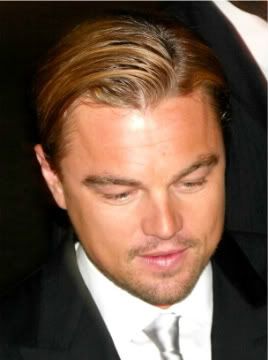
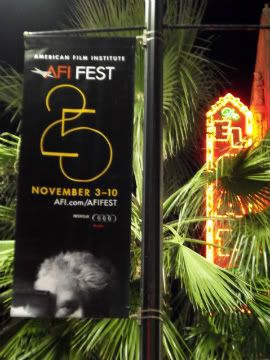

The 25th edition of L.A.’s AFI Fest just recently wrapped, and once again it was a stellar affair, drawing some of the world’s greatest filmmakers to Hollywood to display their latest cinematic works. The weeklong festival featured Gala screenings each night at historic Grauman’s Chinese Theatre, with filmmakers and stars parading the red carpet laid out atop the fabled courtyard. Everyone from big dogs like Clint Eastwood and Leonardo DiCaprio to adorable little ones like The Artist’s canine scene stealer Uggie was there to support their films’ Hollywood premieres.



At times AFI Fest 2011 (again sponsored by Audi which allowed for free admissions to all screenings) seemed like a West Coast fusion of this year’s previous major film festivals (Cannes, Venice, Toronto). Indeed AFI Fest director Jacqueline Lyanga admitted as much when introducing works she’d first been thrilled by earlier at this year’s Cannes Film Fest. Graceful, intelligent, and professional throughout, Miss Lyanga introduced the majority of Gala and Special screenings and took to the stage for the Centerpiece screening and Q&A of this year’s Guest Artistic Director, Pedro Almodóvar.
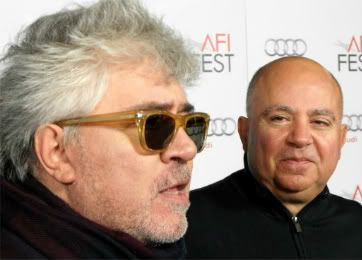

Almodóvar was an inspired choice to follow last year’s inaugural Guest Artistic Director, David Lynch, as both filmmakers are true cinematic originals who have continued to create striking works of art, beholden only to their own internal visions. Additionally, this year’s 25th AFI Fest anniversary coincides with the 25th anniversary of Pedro and brother Agustín’s El Deseo production company founding, so it seemed only appropriate that the Centerpiece Gala celebration was for their company’s initial offering, Law of Desire. In a fascinating overview of his career, Lyanga spoke with Almodóvar before the assembled Grauman’s Chinese crowd for some forty minutes on a variety of subjects, including his obsession with desire. As an important motif in all of his films, and despite the often high price to pay for pursuing it, “ I can’t conceive of a life without desire,” Almodóvar stated emphatically.
Having grown up in the ’60s and ’70s, Almodóvar explained how the Pop Art movement had helped to form his creative sensibilities. His first film memory as a boy, when he and brother Agustín would go hand-in-hand to the local cinema (they still see movies together at least twice a week), was the thrill of watching brightly lit Hollywood Technicolor films. It will come as no surprise to ardent cinephiles that the use of color in Douglas Sirk’s and Alfred Hitchcock’s films was extremely influential on young Pedro, as was the black-and-white cinematography of the German Expressionists, Fritz Lang in particular. Outside the world of cinema, Almodóvar mentioned the great Edward Hopper as a major influence on the look of his films, as well as Velasquez with his use of light and shadow. He additionally noted how the color palate of his films has darkened with time, and how this may partially be due to his current fascination with film noir.
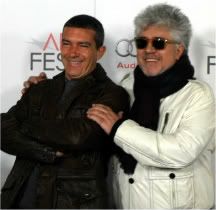
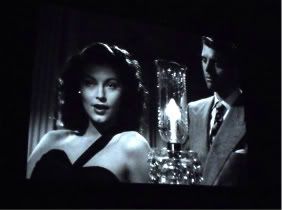
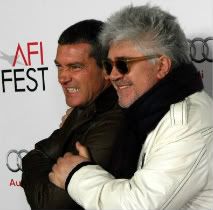
“Noir is the genre that moves me the most … and in fact is what I watch the most now, which is why I picked these noir thrillers,” explained Almodóvar in reference to the four films he chose for his curated sidebar at nearby Grauman’s Egyptian Theatre. Nightmare Alley, The Killers, Eyes Without a Face, and Le Cercle Rouge indeed did look fantastic projected up on the Egyptian’s grand screen (as had David Lynch’s choice of Sunset Boulevard, exhibited there last year), and one can see how Almodóvar’s love of such noir has influenced his more recent work, particularly the current The Skin I Live In.
Almodóvar seemed genuinely thrilled with the night’s festivities, never imagining twenty-five years ago that he and his brother would be walking the red carpet into a packed Grauman’s Chinese screening of their company’s first production. Like his predecessor David Lynch, Almodóvar stressed the importance (and joy) of seeing films on such giant screens as these. “Maybe I’m old fashioned, but movies are supposed to be bigger than the furniture,” he stated, to audience applause. And the films throughout AFI Fest 2011 did in fact look marvelous, the best I’ve seen at any festival yet. While initially (and stridently) a 35mm purist, I must say that with the quantum leap in state-of-the-art digital projection of late, I am now a firm convert. I’d even wager that Law of Desire’s bold colors and crisp details may have looked better in this screening, than they had on opening night in Madrid a quarter century ago.
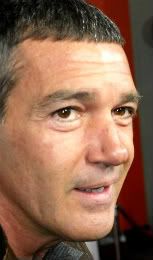
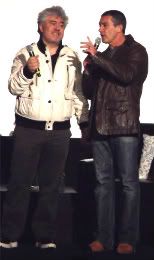
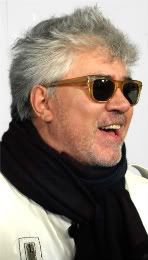
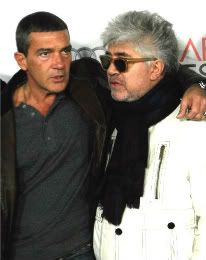
Antonio Banderas, star of Almodóvar’s latest film as well as Law of Desire, was on hand to lend effusive support to his mentor (but alas, no Carmen Maura). Bounding energetically onto the Chinese stage to sing the praises of his friend, Banderas made a point of how Almodóvar almost single-handedly shattered the decades of Franco’s artistic repression in Spain, particularly in regard to the portrayal of homosexuality in cinema. He recalled that even in 1986 when Law of Desire was released, his character’s brutal murder of another was quite palatable to audiences, but that “to kiss another man in his mouth, that was not accepted.” His impassioned and eloquent thanks to Almodóvar for teaching him so many lessons about film, hypocrisy, art and life during their decades-long collaboration rose to a crescendo of love, as the audience applauded and the two Spaniards embraced.
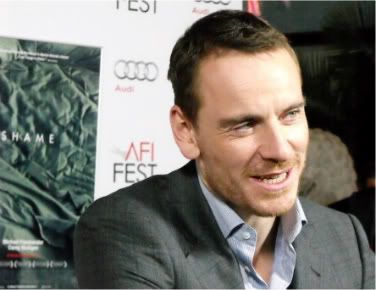

Two nights later on the red carpet for director Steve McQueen’s Shame outside the Chinese Theatre, Michael Fassbender spoke to the same hypocritical double standard that Antonio Banderas had referenced. Fassbender (who has really hit his artistic stride of late, winning the Best Actor prize for Shame at Venice earlier this year) found it “curious” that while violence in film is acceptable to society, films that deal frankly with sexuality are still quite controversial, citing Shame’s NC-17 rating as evidence. (Sadly, perhaps things haven’t changed as much as Antonio Banderas would wish to believe all these years later.)
Still, Fassbender isn’t particularly concerned that the restrictive rating will be a detriment to the film’s overall exposure (not to mention his), and thinks the curiosity factor with that rarely used rating may, in a backhanded way, actually help the film. It would indeed be a shame if such provincial factors weighed against this powerful film’s success, as it fully deserves to be seen by everyone who cares deeply for the state of cinematic art. Fassbender’s achingly committed performance as an addict (in this case sexual) trying to maintain a semblance of normalcy as his life falls apart is brave and true. His character’s attempt at a ‘normal’ dinner date with a co-worker (the excellent Nicole Beharie) becomes increasingly awkward and painful to watch, as he attempts to navigate these unfamiliar waters. Fassbender’s largely internal performance works on dual layers, showing one side to the characters that inhabit the film’s world, and another to the audience via Steve McQueen’s probing camera lens. McQueen’s follow-up to his wrenching debut film Hunger proves he is a major cinematic talent, and the news that he and (Hunger, Shame) star Michael Fassbender are in pre-production on a third collaboration is welcome indeed to cinephiles the world over.



While one of AFI Fest’s primary functions is to serve as a West Coast launching pad for films hoping to grab Oscar voters’ attention, it must also be applauded for the superb exposure it gives to the best of current World Cinema. This year there was a welcome overlap between the two categories, with eight countries’ official foreign-language Oscar submissions being screened at the fest, often with their directors present to discuss the work. Promotional motivations aside, it truly is a privilege to see films of this caliber presented in such an ideal setting, especially since many of these gems will get limited, if any, stateside distribution.
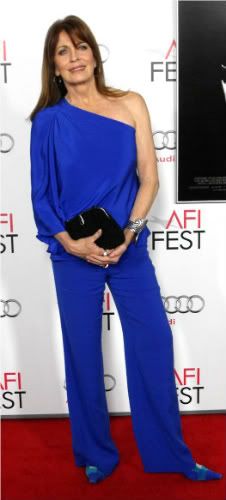


Traveling to Los Angeles for the first time, the great Dardenne brothers were on hand to present and discuss their moving, humanist, and ultimately optimistic Cannes Grand Prix winner, The Kid with a Bike. Though stylistically far removed from Pedro Almodóvar’s canon, their film shares a similar central theme … the strong, often painful desire to be accepted into a family, a family of any type. The deceptively simple film focuses on an 11-year-old boy who refuses to accept the fact that his father has abandoned him. In the dogged pursuit of his father (and the bicycle that represents to him their former bond), he is befriended by a hairdresser (movingly interpreted by Cécile de France) who decides to altruistically take him under her wing. As with all Dardennes films, what little “plot” there is serves primarily as a framework to delve into the struggle for survival in a harsh world, and the importance (and fragility) of connecting to fellow human beings. It’s a lovely film – one of the best of the festival – where just a few expertly placed bars of a Beethoven adagio, or the boy’s rare smile breaking through his protective shell on a sunny picnic, can say so very much.
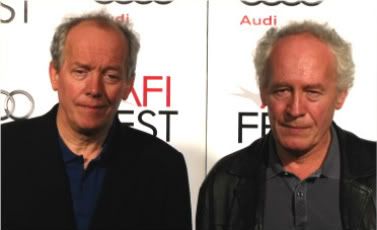
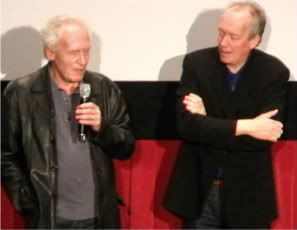
Also on display was the film that shared the Cannes Grand Prix with The Kid with a Bike this year, Nuri Bilge Ceylan’s Once Upon a Time in Anatolia (likewise an Oscar submission). Slow paced yet fascinating throughout, the film ostensibly is about the search for a murdered body and the police procedural after it is found, and yet this again is only a framework to explore the mysteries of everyday life around a rural Turkish town. The nocturnal (seemingly eternal) drive through the Anatolian countryside that takes up most of the film’s first half hints at so much more than the specific quest at hand, with bits of dialogue referencing lives and events that will remain mysteries to the viewer (but are all-important to the characters themselves). The film’s cinematography is ravishing, highlighting straw-colored rolling hills against an inscrutable black sky, which with the dawn gives way to expose Ceylan’s signature ominous gray clouds. The story ends with the victim’s autopsy, which we suspect will supply no answers of import to the affected lives that continue outside the frame of this beautiful film.
It is an autopsy, as well, that opens Aleksandr Sokurov’s brilliant interpretation of Goethe’s Faust, as the introspective Doctor attempts futilely to physically unravel the mysteries of the human soul. Set in an earthy 19th-century Bruegelian village, Sokurov’s camera immerses us fully in the daily chaos of this mud-filled hamlet where Faust soldiers on in his quest for unlimited knowledge. Late in the film there is one jaw-dropping golden close-up of Faust’s obsession, the beautiful Margarete, which has to be one of the most ravishing ever filmed (similar to Grace Kelly’s close-up that Jimmy Stewart awakens to in Rear Window, one of David Lynch’s picks from last year’s festival). With this one shot, Sokurov goes a long way in explaining the ‘worldly pleasures’ part of Faust’s Mephistophelian bargain (though not so much the unlimited knowledge and power aspect). Lead actor Johannes Zeiler was on hand after the screening to answer questions, and praised not only Sokurov, but Russian actor Anton Adasinsky, who gives such a deliciously twisted performance as the Moneylender Mephisto. Though underused, Hanna Schygulla as the Moneylender’s wife floats through the film under an array of increasingly bizarre hats, stealing every scene she’s in. Faust was a well-deserved Golden Lion winner at this year’s Venice Film Festival, and most definitely one of the highlights of AFI Fest 2011.
Yet another world-class filmmaker, Béla Tarr also made the trek to Hollywood to present what he insists is his final film, The Turin Horse. While Once Upon a Time in Anatolia intrigued by suggesting the lives its characters lived outside the one-day time frame of that film, Tarr’s hauntingly beautiful black-and-white meditation focuses like a laser on the mundane day-to-day existence of an old man and his daughter. We share their austere lives in a wind-whipped lonely stone hut far removed from civilization, where their daily routines of eating a boiled potato, donning one’s clothing, or simply staring out a window are painstakingly documented, seemingly in real time. Unlike Ceylan’s film, there appears to be almost no outside life for these characters, and yet when the outside world does impose itself just twice during the 150-minute length of the film, it is an unusually jarring experience.
Aside from these two (almost alien) incursions into their hermetically sealed lives, nothing much happens in the film … and yet, almost all of Life is somehow there. Or the end of life more probably, for when Tarr stood to speak of the film he obliquely referred to it as “a kind of funeral.” The beauty of a languorous film such as this, with its glacial pace and plotless simplicity, is that it frees up one’s mind to wander and wonder, to actively participate in creating a meaning for what one is experiencing. Very few filmmakers have been able to master this artistic feat, and it truly will be a great loss to World Cinema should Tarr make good on his retirement vows.
And yet I can think of no greater capstone to his cinematic career than what he has given us with The Turin Horse. The imagery in the film is indelible, from the drawn-out opening sequence of a horse struggling with its burden against the elements, to a haunting late shot of the daughter’s inscrutable face staring out the window (title notwithstanding, looking eerily like the Turin Shroud). When introducing the film, Tarr was needlessly almost apologetic for what we were about to see, warning … “It’s ugly, slow, miserable,” while outside the Hollywood theatre, “The sun is shining!” When his masterwork ended, he arose and explained that this film was his last because he has done everything that he wants, said everything that he could, and didn’t want to repeat himself or bore the audience. I shall ruefully take him at his word, and simply appreciate the privilege of viewing this great work in such a setting, and in the humble filmmaker’s presence.
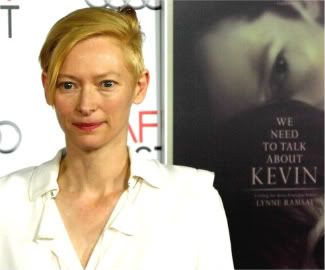
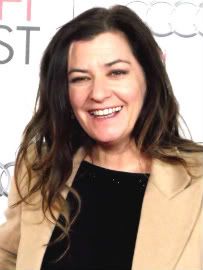

Lest we cinephiles worry too much over What now, Béla Tarr, in response to an audience query Tarr insisted, “I have a future! Do you think I now have to die?” So it was a joy to see him later in the festival happily embracing the star of his penultimate film, The Man from London’s Tilda Swinton. Miss Swinton appeared at the fest in support of Lynne Ramsay’s audacious adaptation of We Need to Talk About Kevin, a very different and disturbing addition to the kid-from-hell canon. It’s wonderful to see such a talented director as Ramsay back behind the camera after such a prolonged absence (her previous film being 2002’s Morvern Callar). As with that film’s Samantha Morton, Kevin is anchored by a go-for-broke performance by its lead actress, and Tilda Swinton has rarely been better.


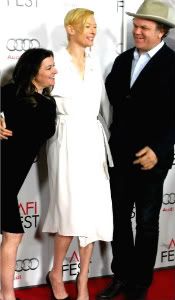

Unable to navigate (or even fathom) the intricacies of motherhood, Swinton’s character is put to the ultimate test after birthing what can only be described as a very bad seed. And yet even after her world has fallen completely apart, she continues to soldier on, trying to guiltily clean up the crimson disaster that somehow was always staring her in the face. Ramsay’s visual motif is masterful throughout (think Kubrick’s bloody Overlook elevator), which is particularly impressive considering (as she noted before the screening) that Kevin was filmed in a mere thirty days, with no more than three takes per shot. Ramsay and screenwriting/life partner Rory Kinnear appeared to be thoroughly enjoying the entire experience of walking Grauman’s Chinese red carpet, and when queried about the film’s Oscar chances, Ramsay tongue-in-cheekily replied, “We should win the Oscar … it’s the best film ever!” Aside from the aforementioned cinematography, direction, screenwriting and Swinton’s lead performance, an additional nod for young Ezra Miller as the hypnotically chilling teenage son would be thoroughly deserved.

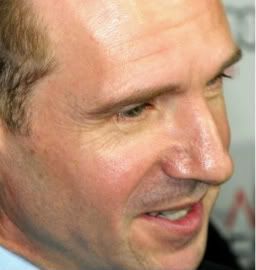
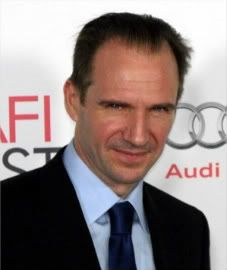
Speaking of fierce performances, one would be hard pressed to find two more committed, thrilling ones than the pair given by Vanessa Redgrave and Ralph Fiennes in the latter’s directorial debut, Coriolanus. As a power-hungry mother and son in Fiennes’ updating of one of Shakespeare’s bloodiest plays, these two fine actors sink their teeth into their roles, showing a ferociousness seldom seen in their work. In a follow-up discussion, Fiennes stated he was always dead set on his friend Redgrave for the role of Volumnia, and that she was the first cast member that he called. She naturally accepted, but due to financing issues they then had to wait three years before filming could begin. It was worth the wait, however, to be able to see one of our greatest living actresses finally get a role that befits her considerable thespian abilities. The scene where she drops to her knees to beg her son’s mercy is truly one for the acting history books, and we can only hope that she’ll be justly recognized when awards are distributed.


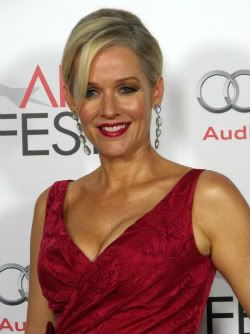
Unfortunately, Shakespeare’s rich words and difficult cadences will likely have to take a back seat come awards time to a film where words are barely even spoken. I too will keep my verbiage to a minimum here, except to note that as a lover of the artistry of silent films, I found so very little of it in the inaptly titled The Artist, perhaps my biggest disappointment of the festival. Not wanting to be overly harsh to a film that does at least try to honor a worthy subject, I found it a cloying, cliché filled novelty which exhibited little of the rough-edged natural exuberance and pure talent seen in the best of classic silent films.
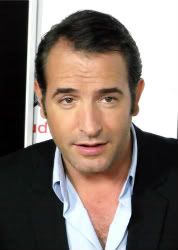

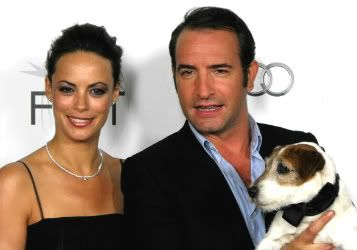
Not helping matters, Jean Dujardin (Cannes’ Best Actor winner earlier this year) bears an uncanny resemblance to both Gene Kelly and Frederic March, from whose respective classics Singin’ in the Rain and A Star is Born this gimmicky pastiche liberally borrows. Most unforgivable in my mind, however, is the overbearing, wall-to-wall musical score (the kind that tends to win Oscars), whose most egregious crime is to appropriate Bernard Herrmann’s haunting Scene d’Amour composition from Vertigo and plaster it in full over the film’s climax. I’m undoubtedly in the minority on this one (see colleague Marc van de Klashorst‘s alternate take here), but I tend to become Grumpy when films get this relentlessly Peppy.
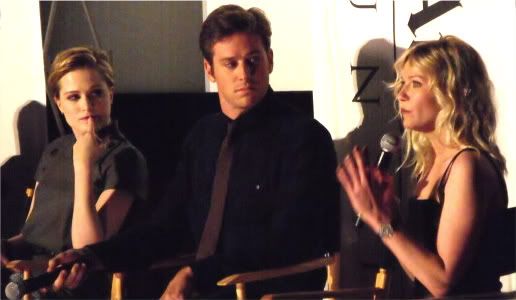
In no danger of being labeled peppy (thankfully) for her Cannes Best Actress winning performance this year, Kirsten Dunst was on hand at AFI Fest 2011 not only to represent her breakthrough role in Lars von Trier’s Melancholia, but also to participate in a “Young Hollywood” discussion panel. Joining Armie Hammer, Evan Rachel Wood, and Anton Yelchin on stage at the Egyptian Theatre, Dunst seemed the most thoughtful and introspective of the group (Wood definitely won the peppy prize on that afternoon). When the moderator segued onto the subject of the now infamous Cannes press conference, citing Lars von Trier’s controversial comments about “sympathizing with Nazis,” Dunst was quick to correct her.
“Lars is a friend of mine,” said Dunst protectively. “He didn’t sympathize at all, just to correct your words. Yeah, it was difficult of course, especially watching someone you care about kind of dig themselves into a hole. But we were fortunate enough that they [the jury] viewed the film separately, and … it worked out for me in the end, so …” It had indeed, as Dunst exhibits a hitherto unseen depth and gravitas in the role of depressed bride Justine. (When a character is as self-destructive as hers, the destruction of the entire world is really no big thing.) She said she was helped immensely by von Trier’s on-set vulnerability and openness, what with his having experienced previously much of what her character felt as well. While I was not a great fan of the end result (I prefer my end-of-world depictions a bit less literal, instead more circumspect and poetic as in The Turin Horse), there’s no faulting the wounded performance of Miss Dunst, who hopefully now will be offered a much greater range of dramatic roles.

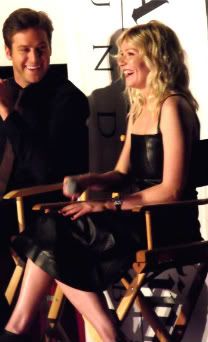
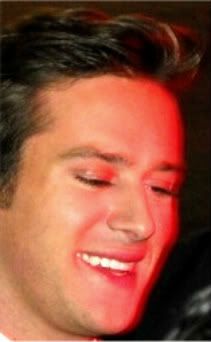
The festival’s second large Grauman’s Gala featured yet another breakthrough lead performance, this time by Michelle Yeoh as Burma’s reluctant leader (and Nobel Peace Prize winner) Aung San Suu Kyi in Luc Besson’s intimate epic, The Lady. This very moving film focuses primarily on the home life and personal sacrifices that Suu Kyi, British husband Michael Aris (yet another excellent David Thewlis performance), and their two sons were forced to endure throughout their long fight to free Burma from repression under the thumb of its brutal dictatorship. While in many ways a traditional biopic (which was really the best option when hoping for the biggest world audience), I felt Besson’s balancing of the historical and the intimate was pitch perfect, and he allowed Yeoh the space to create a fully rounded character (his original cut of the film was over four hours). Aung San Suu Kyi’s ongoing story is such an important one for the world to know, and understanding this, Yeoh became the film’s driving force from its inception onward. Her performance is filled with small, subtle, beautiful touches (her wordless breathing at crucial moments particularly impressed me), and her commitment to ensuring that Suu Kyi’s story be told has driven her to take a year out of her career to promote the film worldwide. Perhaps I’m idealistic, but one would like to believe that if the film were a big enough global success, it could in some small way help right the terrible wrongs that continue to be inflicted upon the good people of Burma. Kudos for Miss Yeoh (and all others involved in the film) for fighting this good cinematic fight.
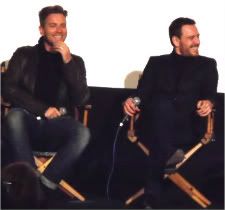
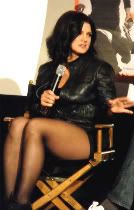
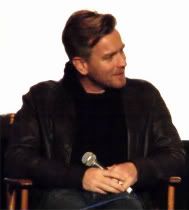
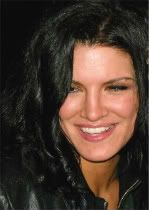
Good fights of an altogether different sort were the primary attraction of Steven Soderbergh’s latest action popcorn flick Haywire, but damn if it wasn’t a fun, slick, top-notch addition to that genre. An international cast including Michael Fassbender, Ewan McGregor, Michael Douglas, and Antonio Banderas all ably support mixed martial arts fighter Gina Carano in her first starring role as a badassed, double-crossed black ops fighting machine. Soderbergh is a master of editing, shot placement, and pace, and though by no means high art, the film really was a satisfying thrill ride, accomplishing eveything it set out to do. The actors all did their own tightly choreographed fight scenes, adding greatly to the film’s immediacy, and Soderbergh, McGregor, Fassbender, and Carano took to the Grauman’s Chinese stage for a rousing post-screening discussion. Explaining how he wanted to create a James Bond-style action flick starring a woman other than Angelina Jolie, Soderbergh had his panel of actors in stitches throughout. Their joy in working with Soderbergh seemed genuine and infectious, which translated to the big screen, and I wouldn’t be at all surprised if this film becomes a huge success, perhaps even spawning its own franchise.
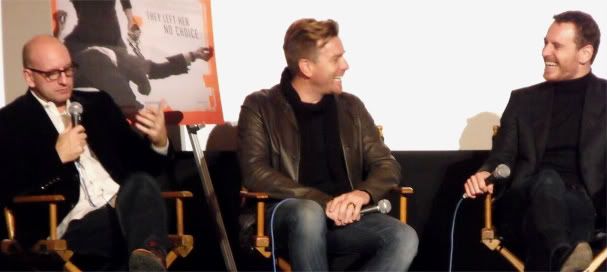
In polar cinematic opposition to Soderbergh’s film, Kim Ki-duk’s fascinating, intimate self-portrait Arirang was a moving, revelatory exploration of what it really means to be a film artist. Kim withdrew from filmmaking (and the world) in 2008 after a traumatic on-set incident, moving off the grid and into a tent in the Korean mountains. Yet the powerful compulsion to film (anything, even just himself) eventually overwhelms him, and his necessity to attempt to create art becomes too essential to ignore, resulting in this amazing HD cam filmed testament. It was heartening to see a filmmaker of unique talent (his Spring, Summer, Fall, Winter … and Spring moved me immensely, a segment of which features prominently in this film), pull himself back from the brink and dip his toe back into the world of cinema.
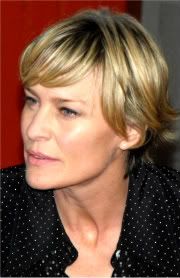
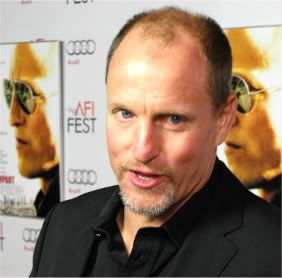
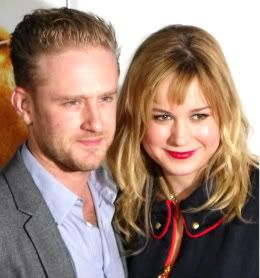
Rampart, Oren Moverman’s follow-up to his excellent 2009 directorial debut The Messenger, reunites that film’s actors Woody Harrelson and Ben Foster in this story of a corrupt East L.A. cop whose life is rapidly spiraling out of control. I’ve rarely seen a Harrelson performance that was not at least interesting, and here he is given one of his best and most complex roles. While the film around him is a bit of a clichéd mess, Harrelson is never less than fascinating, navigating the broken relationships that pile up seemingly wherever he turns. If not for an off-putting drug fueled club scene, I think he could have found himself in the running for year-end awards, and might still. Brie Larson as his rebellious eldest daughter has some fine moments, and Robin Wright puts to bed for all time her Jenny/Princess Bride persona with one deliciously delivered line on sexual preferences, but the real supporting standout was Sigourney Weaver as one of Harrelson’s terse agency superiors. Her line readings and frank intelligence warrant a much larger role in a film more worthy of her talent.



Closing out the festival was the North American premiere of The Adventures of Tintin, Steven Spielberg’s first foray into directing animation, and a rollicking film destined to be a runaway holiday hit (and huge franchise tent pole). Utilizing state-of-the-art motion capture animation, the film is a visual joy from playful opening credits to double-whammy climax. It’s that second whammy that I had slight issues with, however, coming so soon after one of the most thrilling set pieces Spielberg has ever filmed … the careening, go-for-broke chase sequence down a bustling Moroccan hillside city. Justifiably breathtaking, one could’ve used a bit more downtime to actually catch one’s breath before plowing right back into yet another action sequence (which does pale in comparison to the Moroccan one, but then what wouldn’t). John Williams’ playful score and Jamie Bell’s gung-ho Tintin voice work are both excellent, but again it’s Mr. Anonymous Andy Serkis as Captain Haddock who nearly steals the show. (More on Tintin by my colleague Ciro Di Lella here.)
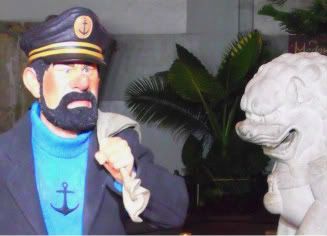

Back at the AFI home base at the nearby Roosevelt Hotel, Jamie Bell and his fellow castmates celebrated Tintin’s successful screening inside the historic Blossom Room, site of the very first Academy Awards ceremony. Last year all of the eventual top Oscar winners (The King’s Speech, Black Swan, The Fighter) began their march towards the Kodak Theatre podium at AFI Fest 2010, and I suspect a similar situation may unfold again this year. And yet for me, it was the opportunity to see such diverse and thrilling works by many of the world’s great filmmakers (often in their presence) that mattered most at AFI Fest 2011. You know that a festival must be doing something right when it is able to entice such esteemed film artists as Pedro Almodóvar, Béla Tarr, the Dardenne brothers, Steve McQueen, Lynne Ramsay, New German cinema masters Werner Herzog and Wim Wenders, Clint Eastwood and numerous other important cinema talents to participate. While easy to disparage the circus-like festivities of the Grauman’s red carpet, there’s no denying the pride many of the world’s premiere filmmakers felt in seeing their work presented in such a historic setting, before such appreciative audiences. Jacqueline Lyanga and the rest of the AFI Fest crew did a brilliant job of balancing Hollywood glitz with showcasing the best that current World Cinema has to offer, so indeed a grateful bravo, and here’s to the next twenty-five!
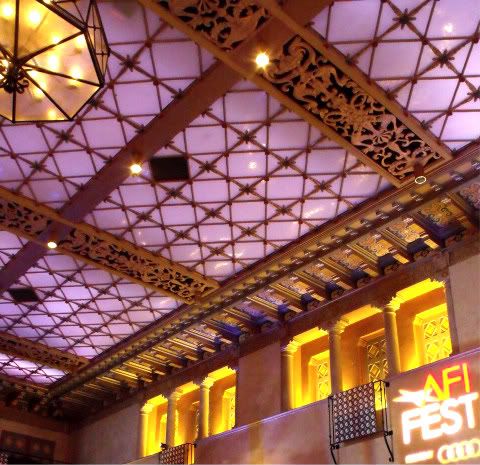
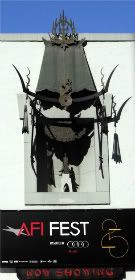 AFI Top Ten
AFI Top Ten
1. The Turin Horse
2. Faust
3. Once Upon a Time in Anatolia
4. The Kid with a Bike
5. Arirang
6. Shame
7. Coriolanus
8. We Need to Talk About Kevin
9. The Lady
10. Haywire
All photos by Steve Striegel, exclusively for ICS
